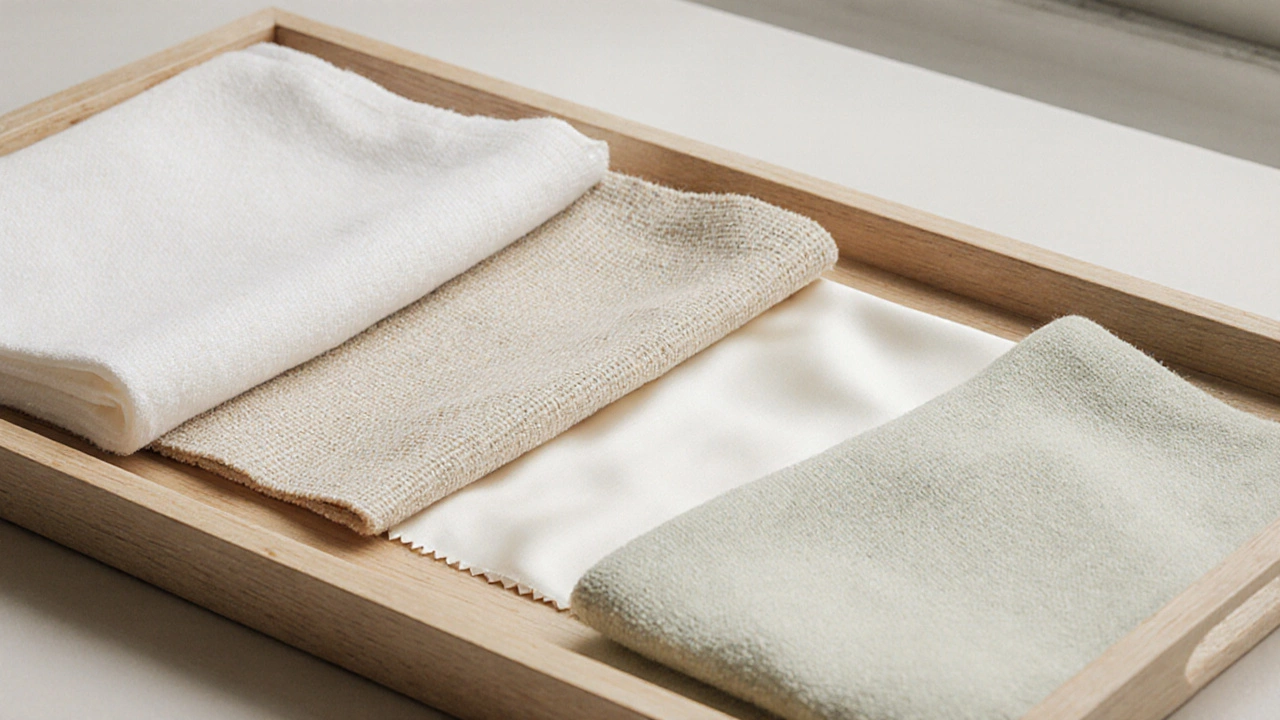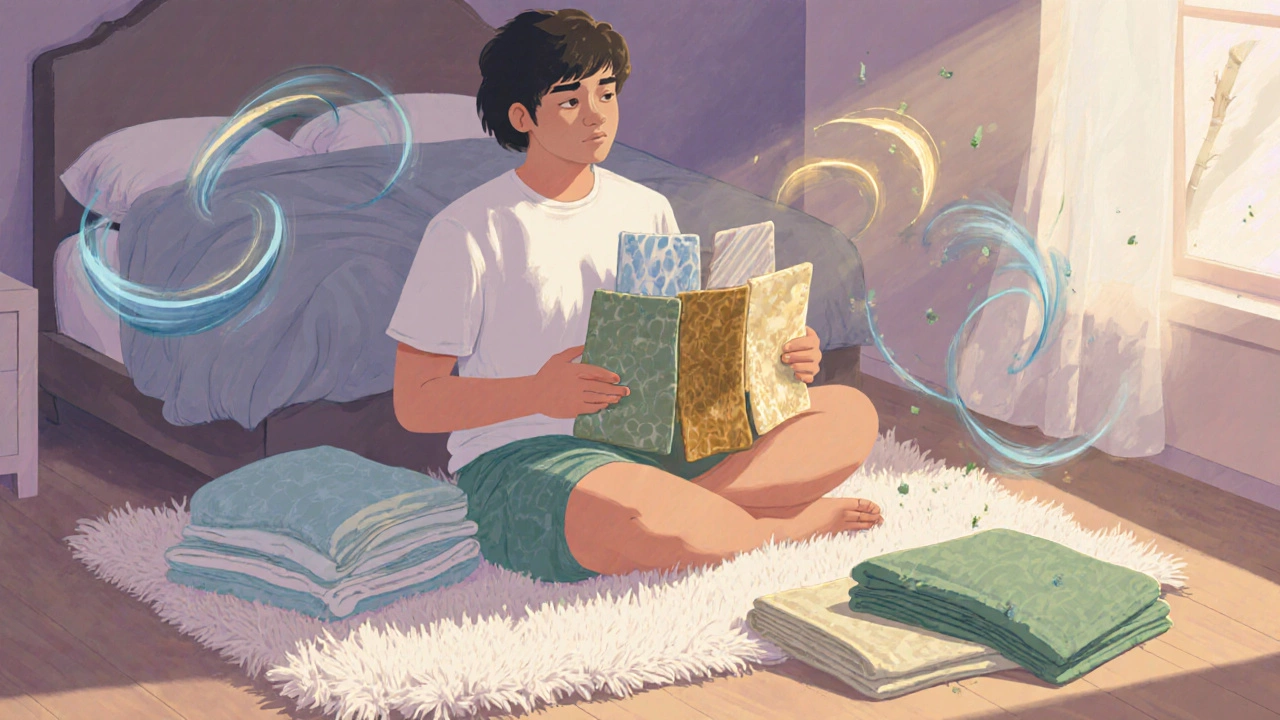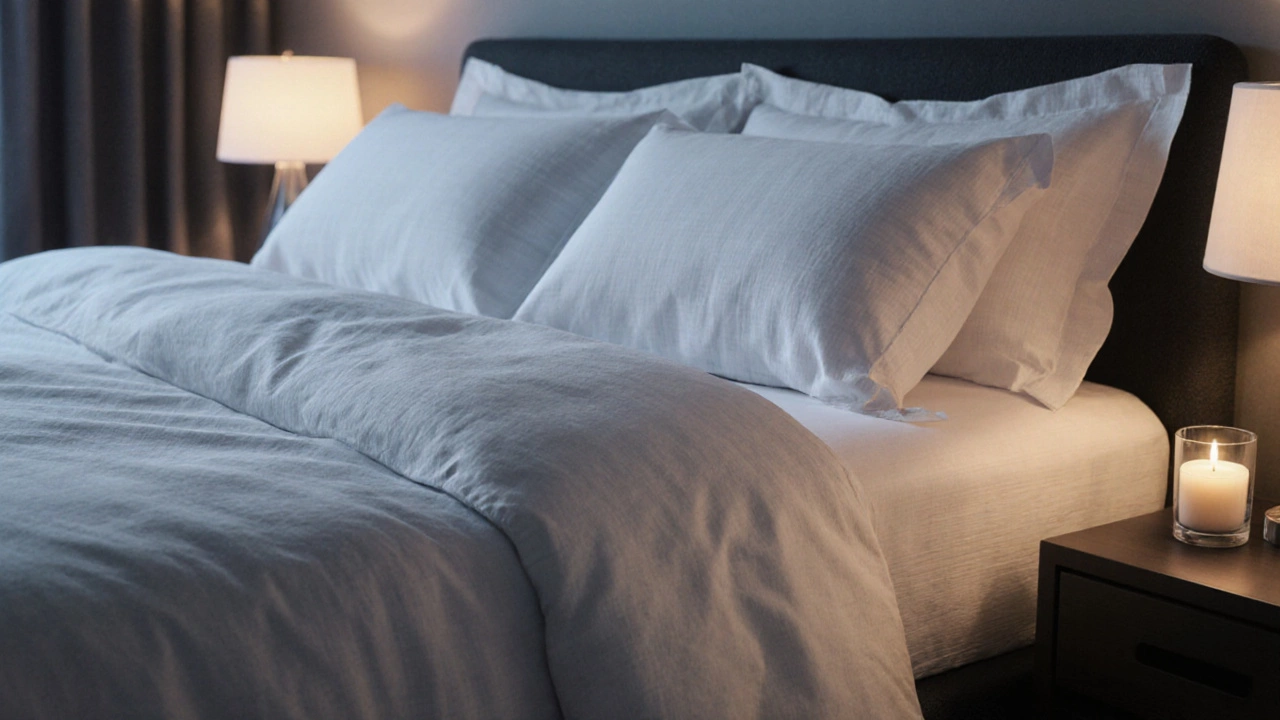When you hear the phrase Bedding is a collection of textiles that cover your mattress and create the sleeping surface, including sheets, blankets, and pillowcases, you probably picture a comfy bed at the end of a long day. But not all bedding is created equal, and the best type of bedding depends on what you value most - temperature regulation, durability, luxury feel, or easy care.
Why the Material Matters
Think of bedding like a shirt for your mattress. The fabric you choose directly affects how hot or cool you feel, how often you need to wash it, and how long it lasts. Below are the three attributes that matter most when you compare any bedding material:
- Thread count is the number of threads woven into a square inch of fabric. Higher numbers usually mean a smoother hand feel, but they don’t guarantee quality if the yarn is cheap.
- Weave type (percale, sateen, twill) determines breathability and drape. Percale feels crisp, sateen feels silky, and twill offers a subtle texture.
- Fill power applies to duvets and pillows - higher fill power means fluffier, more insulating comfort.
Popular Bedding Materials Explained
Let’s walk through the five most common sheet materials you’ll find on the market today, each introduced with its own microdata definition for easy reference.
Cotton sheets are a natural fiber made from the seed hair of the cotton plant, prized for softness, breathability, and durability. Within cotton, you’ll see two main grades: Egyptian (long staple) and Pima (Supima). Both offer a buttery feel, but Egyptian cotton often carries a higher price tag.
Linen sheets are woven from flax fibers, giving them a relaxed, slightly textured look and an airy feel that gets softer with each wash. Linen excels at moisture wicking, making it ideal for hot sleepers.
Silk sheets are crafted from the natural protein fibers of silkworm cocoons, delivering a luxuriously smooth surface and hypoallergenic properties. They’re great for skin and hair health but require gentle care.
Microfiber sheets are made of ultra‑fine synthetic polyester fibers that mimic the softness of natural fabrics while being budget‑friendly and wrinkle‑resistant
Bamboo sheets are derived from the pulp of the bamboo plant, offering a silky hand feel, natural antimicrobial qualities, and excellent temperature regulation
Which Material Wins for Specific Needs?
Instead of declaring a single "best" option, it helps to match material strengths to your personal priorities.
- Cool, hot‑climate sleepers: Linen or bamboo excel at airflow and moisture wicking.
- Luxury feel & skin care: Silk provides the smoothest surface and reduces friction for hair and skin.
- Everyday durability & easy care: High‑quality cotton (percale weave) and microfiber hold up to frequent washing.
- Allergy‑prone families: Silk and bamboo naturally resist dust mites; look for certified hypoallergenic finishes.
- Budget‑conscious shoppers: Microfiber delivers softness at a fraction of the cost of natural fibers.

Side‑by‑Side Comparison Table
| Material | Typical Thread Count Range | Breathability | Feel | Care Level | Price (per set) |
|---|---|---|---|---|---|
| Cotton | 200‑800 | High | Crisp to buttery | Machine wash, tumble dry | $$ |
| Linen | 80‑200 | Very High | Textured, softens over time | Machine wash gentle, line dry | $$$ |
| Silk | 300‑600 (momme weight) | Medium | Ultra‑smooth, cool to touch | Hand wash or delicate cycle | $$$$ |
| Microfiber | 300‑800 | Medium‑High | Soft, plush | Machine wash, quick‑dry | $ |
| Bamboo | 200‑600 | High | Silky, slightly drapey | Machine wash, low heat dry | $$ |
Pro Tips for Getting the Most Out of Your Bedding
- Buy a full set (flat sheet, fitted sheet, pillowcases) from the same material to keep the feel consistent.
- Match your pillowcase material to your skin type - silk or satin helps reduce friction for hair and acne‑prone skin.
- Consider a mattress protector made of breathable cotton or bamboo to extend the life of your sheets.
- Rotate your sheets every few weeks to avoid uneven wear, especially with high‑thread‑count cotton.
- If you’re on a budget, start with a high‑quality microfiber set and upgrade to natural fibers later.

Maintenance Basics - Keep Your Bedding Fresh
Proper care not only preserves comfort but also prevents odors and allergens. Here’s a quick routine:
- Temperature: Wash sheets in warm water (40°C/104°F) for cotton and linen; use cool water (30°C/86°F) for silk and bamboo to avoid damage.
- Dryer: Toss cotton and microfiber in the dryer on low heat; air‑dry silk and linen to keep fibers intact.
- Detergent: Choose a gentle, fragrance‑free detergent for natural fibers; avoid chlorine bleach.
- Stain removal: Spot‑treat with a mild solution of water and baking soda before the wash cycle.
Frequently Asked Questions
Which sheet material is best for hot sleepers?
Linen and bamboo are top picks because their natural fibers allow air to circulate and wick moisture away, keeping the body cool throughout the night.
Do high thread counts always mean better sheets?
Not necessarily. A 300‑thread‑count Egyptian cotton can feel smoother than a 600‑thread‑count polyester blend. Look at the type of yarn and weave first.
Can I put silk sheets in the dryer?
It’s safest to air‑dry silk or use a tumble dryer on the lowest heat setting with a delicate cycle. High heat can cause the fibers to become brittle.
How often should I replace my sheets?
For high‑quality cotton or linen, expect 5‑7 years of good use. Synthetic blends may need replacing sooner, around 3‑4 years, especially if you notice thinning or pilling.
Is bamboo truly sustainable?
Bamboo grows fast, needs little water, and regenerates without replanting, making it a more eco‑friendly option than conventional cotton, provided the manufacturing process avoids harsh chemicals.
Next Steps: Choose, Test, Enjoy
Now that you’ve seen the strengths of each material, the real work is simple: pick the one that matches your top priority, order a single set to try it out, and feel the difference for yourself. If the first set doesn’t hit the mark, most reputable retailers offer a 30‑day return - a low‑risk way to experiment.
Remember, the best type of bedding isn’t a universal answer; it’s the one that makes you look forward to bedtime night after night.

